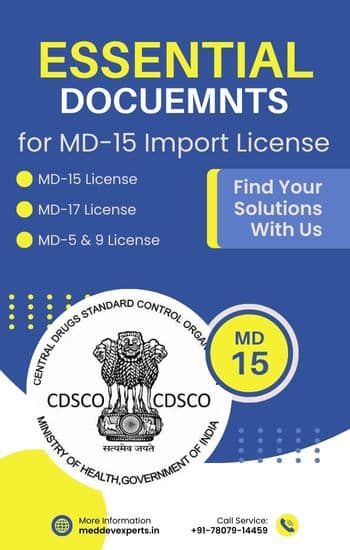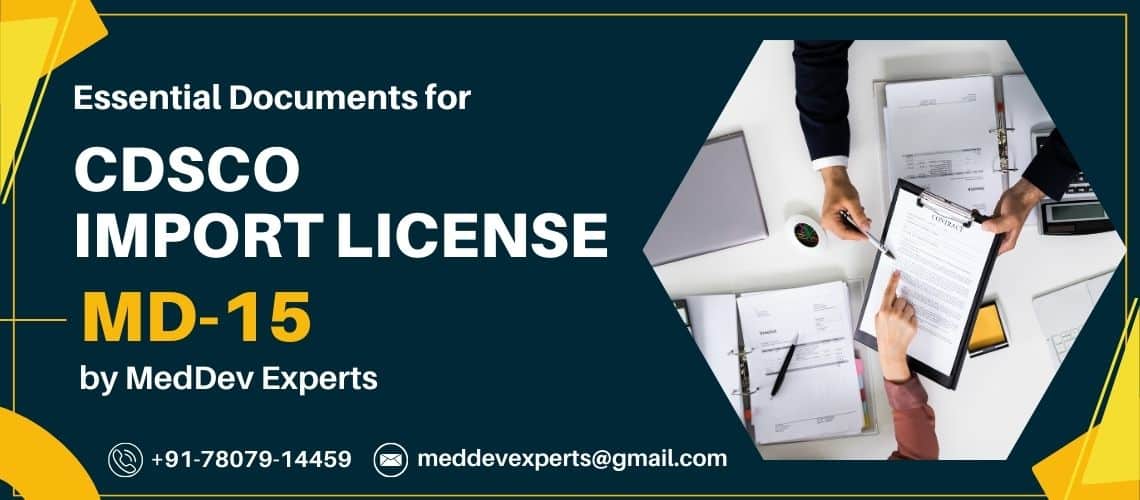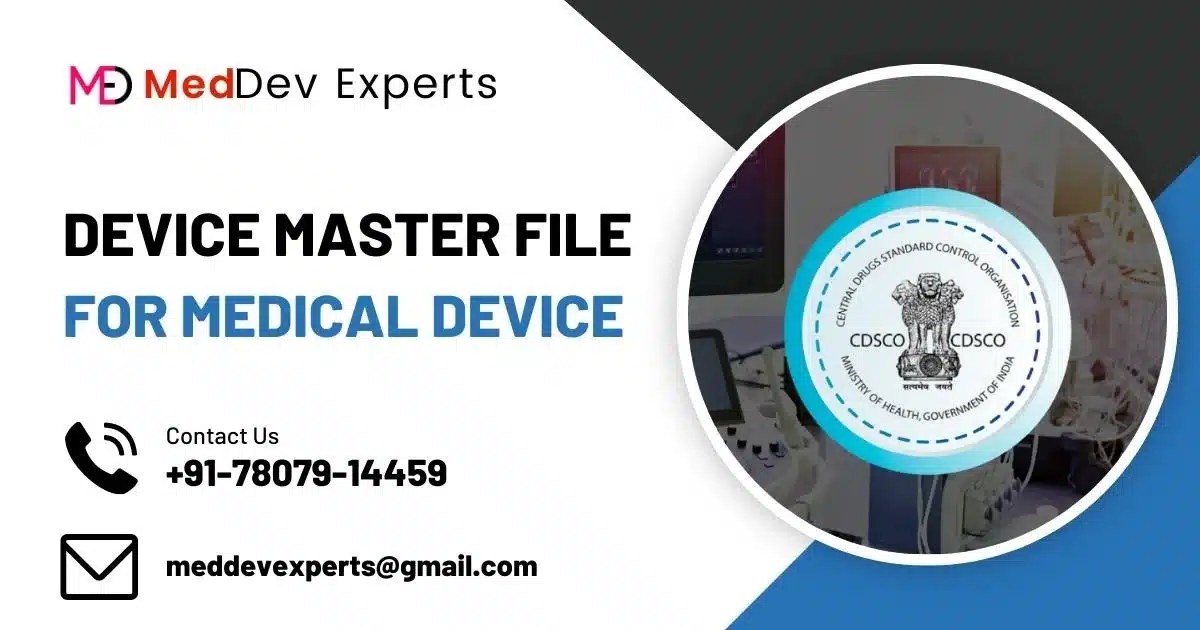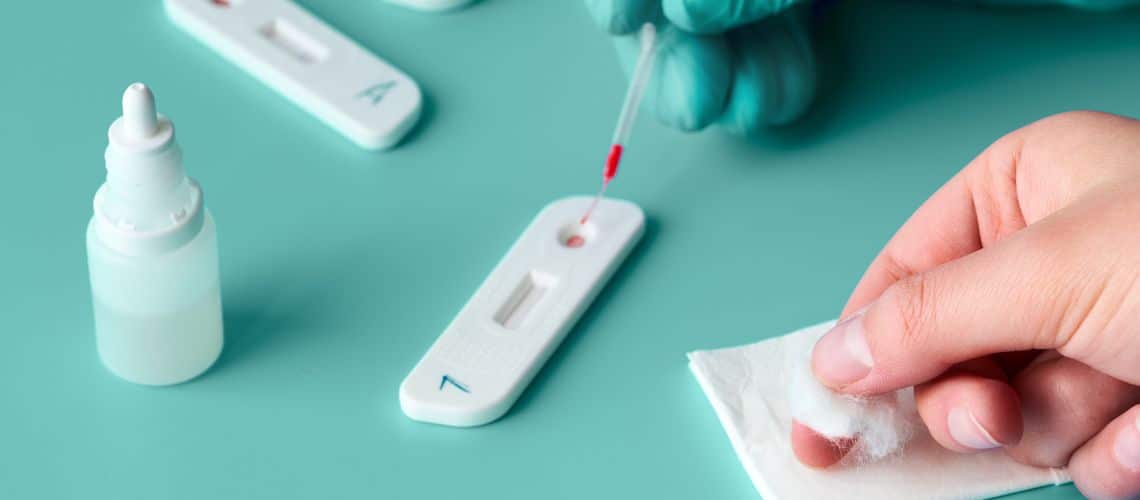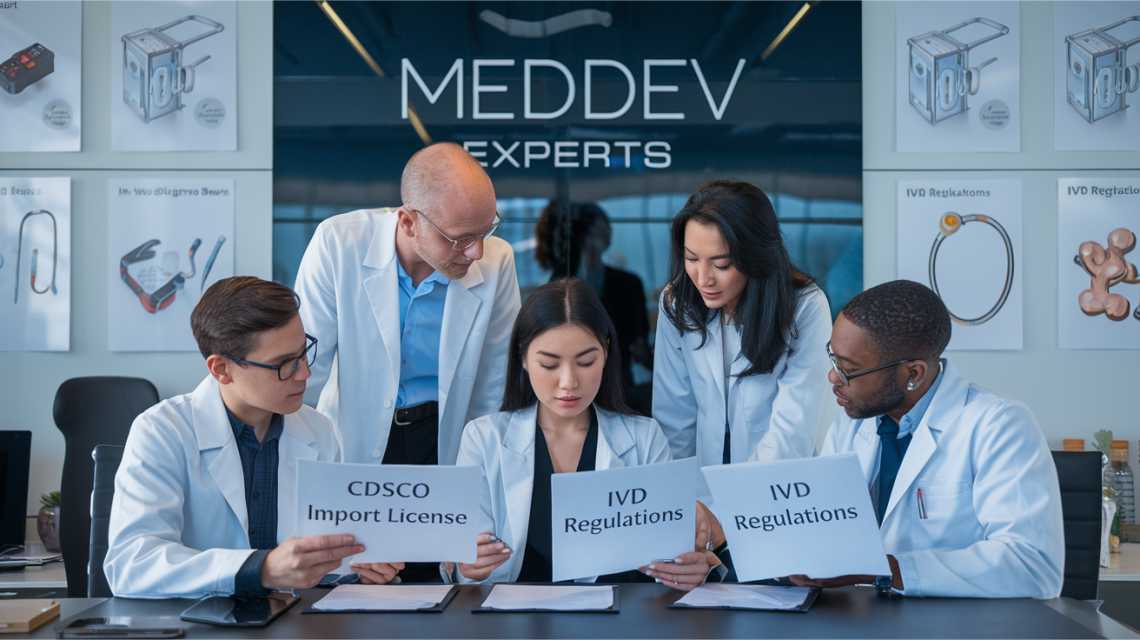Essential Documents for MD-15 License: CDSCO Import License
Thinking about importing medical devices into India? Navigating the Central Drugs Standard Control Organisation (CDSCO) can feel overwhelming. This page breaks down the essential documents you’ll need to gather for the MD 15 import license, streamlining the process and helping you understand the key requirements for bringing your medical devices to the Indian market.
Don’t let documentation challenges block your path to the Indian medical device market. This comprehensive guide will walk you through all the essential documents needed for your MD-15 license, from the Device Master File requirements to the specific additional documentation for In-Vitro Diagnostic devices. We’ll also provide you with a step-by-step preparation guide, submission process insights, and expert guidance to ensure your path to CDSCO approval is as smooth as possible. ✅
Understanding MD-15 and CDSCO Import Licensing
What is Form MD-15 and its purpose
Form MD-15 is the official license document issued by the CDSCO that permits the importation of medical devices into India. Its primary purpose is to regulate and control the import of medical devices to ensure they meet India’s safety and quality standards before being sold or distributed in the Indian market. The MD-15 license is issued after successful evaluation of an application submitted through Form MD-14.
Key features of the MD-15 license:
Validity: Indefinite, but requires retention fee payment every five years
Cancellation: License is cancelled if retention fee is not paid
Exclusivity: License is specific to the importer who obtained it and cannot be used by other firms
Legal framework governing medical device imports in India
The regulatory framework for medical device imports in India has evolved significantly in recent years. Medical devices are classified based on their risk levels, which determines the licensing requirements:
| Device Class | Risk Level | Import License Requirement |
|---|---|---|
| Class A (non-measuring, non-sterile) | Low | Only CDSCO registration |
| Class A (measuring, sterile) | Low-moderate | MD-15 license required |
| Class B | Moderate | MD-15 license required |
| Class C | Moderate-high | MD-15 license required |
| Class D | High | MD-15 license required |
Role of CDSCO in medical device regulation
The CDSCO is India’s apex regulatory body responsible for medical device regulation and import control. CDSCO’s responsibilities include:
Evaluating import license applications
Issuing MD-15 licenses to qualified applicants
Ensuring imported medical devices comply with Indian safety standards
Monitoring compliance after license issuance
Regulating quality and performance standards for medical devices
Registering overseas manufacturing sites
When an import license is required
An MD-15 import license is mandatory for entities seeking to import medical devices into India. Entities eligible to apply include:
- Wholesalers of medical devices
- Foreign manufacturers (through appointed Indian authorized agents)
- Research institutions requiring devices for research purposes
- Healthcare providers/facilities
- Authorized agents with valid wholesale licenses
It’s important to note that while most medical devices require an MD-15 license, recent regulations have exempted Class A non-measuring and non-sterile devices, though they still require CDSCO registration.
Now that we understand what MD-15 License is and when it’s required, let’s explore the essential documentation requirements needed to successfully apply for an MD-15 import license.
Essential Documents Required for MD-15 License: CDSCO Import License
Now that we understand what MD-15 License is and its importance in CDSCO import licensing, let’s examine the essential documentation required for a successful MD-15 Registration.
A. Application Forms and Formats
To initiate the MD-15 license application, you must submit a properly completed Form MD-14. This form serves as your official request to import medical devices into India and must be accompanied by a covering letter addressed to the CDSCO.
B. Power of Attorney
A Power of Attorney document is required from the foreign manufacturer, authorizing the Indian agent to act on their behalf for regulatory matters in India. This document establishes the legal relationship between the manufacturer and their Indian representative.
The Free Sale Certificate (FSC) must be issued by the regulatory authority of the country of origin, confirming that the medical device is legally sold and distributed in that country. This document validates that the product meets safety and quality standards in its home market.
A valid ISO 13485:2016 certification is mandatory, demonstrating that the manufacturer has implemented a quality management system specifically designed for medical devices.
E. QMS Audit Report
Recent Quality Management System audit reports must be submitted to verify ongoing compliance with quality standards. These reports provide evidence of the manufacturer’s adherence to established quality protocols.
For manufacturers using European standards, a CE certificate or equivalent international certification is necessary to demonstrate compliance with essential safety requirements.
G. Company Registration Documents
Documents verifying the legal status of both the foreign manufacturer and the Indian authorized agent must be submitted.
The Plant Master File contains comprehensive information about the manufacturing facility, including:
| Component | Description |
|---|---|
| Location details | Physical address and contact information |
| Layout specifications | Floor plans and production area designs |
| Manufacturing processes | Overview of production methodologies |
| Quality control measures | Systems to ensure product consistency |
I. Manufacturing License
A valid manufacturing license from the country of origin is essential to prove the legitimacy of the manufacturing operation.
The DMF includes detailed specifications of the device, including:
- Design information
- Intended use
- Materials used
- Risk assessment data
- Clinical data (if applicable)
This document is a formal statement from the manufacturer declaring that the product meets all relevant regulatory requirements and standards.
Documents detailing the legal constitution of the authorized agent in India must be provided, including business registration certificates.
The Indian authorized agent must possess a valid MD-42 wholesale license for medical devices, which must be submitted as part of the application package.
With all these essential documents properly prepared and submitted, your MD-15 application will have a stronger chance of approval. In the next section, we’ll take a deeper dive into the Device Master File for MD-15 Import License, which is one of the most critical components of your application.
Now that we’ve examined the essential documentation requirements for the MD-15 application, let’s delve into the specifics of the Device Master File, which is a critical component of your CDSCO import license application.
A. Executive Summary
The executive summary provides a concise overview of your medical device, its intended use, and key regulatory information. This section should highlight the device’s compliance with Indian regulatory requirements and summarize the contents of your Device Master File.
B. Power of Attorney
A Power of Attorney document is required from the foreign manufacturer, authorizing the Indian agent to act on their behalf for regulatory matters in India. This document establishes the legal relationship between the manufacturer and their Indian representative.
B. Device Description and Specifications
This section must comprehensively detail your device’s physical and technical characteristics, including:
- Design specifications
- Materials used
- Performance parameters
- Intended use
- Target patient population
Document all potential risks associated with your device and the measures implemented to mitigate them. The risk analysis should be done as per ISO 14971:2019.
D. Essential Principle Checklist
Provide a comprehensive checklist demonstrating how your device complies with all applicable essential principles of safety and performance as per Indian regulations.
Submit exact copies of:
Product labels
Packaging inserts
User manuals
Instructions for use (IFU)
G. Device Design and Manufacturing Process
Present detailed information about:
- Design processes
- Manufacturing steps
- Quality control procedures
- Flow charts illustrating the production process
H. Design Verification and Validation
Submit evidence that your device:
Meets design specifications
Functions as intended
Is safe for its intended use
I. Biocompatibility Validation Data
For devices contacting the human body, provide test results confirming material biocompatibility according to ISO 10993 standards.
J. Medicinal Substances Data
If your device incorporates pharmaceutical substances, include comprehensive data on:
- Drug characteristics
- Concentration
- Release mechanism
- Safety profile
K. Additional Technical Requirements
Complete your Device Master File with the following specialized documentation as applicable:
Biological Safety (TSE/BSE) verification
Sterilization validation for sterile devices
Software verification for devices with software components
Animal studies and preclinical data
Stability validation
Clinical evidence supporting safety and efficacy
Post-market surveillance data
Batch release certificates from three consecutive production runs
With this comprehensive Device Master File prepared according to CDSCO guidelines, you’ll be ready to address the additional requirements for In-Vitro Diagnostic (IVD) devices, which we’ll explore in the next section.
Additional Requirements for Device Master File for In-Vitro Diagnostic (IVDs) Devices
Now that we’ve examined the essential components of a Device Master File for MD 15 Import License, let’s focus on the additional requirements specifically for In-Vitro Diagnostic (IVD) devices. IVDs have unique considerations due to their diagnostic nature and alignment with international standards like ISO 13485.
A. Analytical Studies
For IVD devices, comprehensive analytical studies must be conducted and documented to demonstrate the device’s performance characteristics. These studies should align with ISO 13485 quality management systems, which CDSCO has proposed adopting as part of its regulatory framework.
B. Specimen Type
Documentation must clearly specify all validated specimen types that can be used with the IVD device. This information is crucial for ensuring proper use and reliable results in clinical settings.
C. Agreement with Reference Methods
Data demonstrating correlation between the IVD device and established reference methods must be provided. This helps establish the device’s validity within the existing diagnostic landscape.
D. Repeatability
Evidence of the device’s ability to produce consistent results under identical testing conditions must be documented, adhering to quality management principles outlined in ISO 13485.
E. Cross-Reactivity
Documents must detail potential cross-reactivity with similar compounds or interfering substances that might affect test results. This is essential for ensuring accurate diagnostics.
F. Performance under Varied Conditions
The following table outlines key performance variables that must be documented:
| Variable | Documentation Required |
|---|---|
| Temperature | Performance at different temperature ranges |
| Humidity | Effect of humidity variations on results |
| Storage | Stability under recommended storage conditions |
| Transport | Performance after transport simulation |
G. Reproducibility
Documentation showing consistent performance across different operators, laboratories, and testing conditions must be included to comply with international quality standards.
H. Analytical Sensitivity
Detailed information on the lowest detectable concentration of the target analyte must be provided, including:
- etection limits
- Quantification limits
- Validation methodology
I. Analytical Specificity
Evidence demonstrating the device’s ability to accurately identify the target analyte in the presence of other substances must be submitted.
J. Metrological Traceability of Calibrator and Control Material Values
Documentation must prove traceability to recognized reference materials or established reference methods, ensuring alignment with international standards.
K. Measuring Range of the Assay
Clear documentation of the validated measuring range, including:
- Lower and upper limits
- Linearity data
- Precision at clinical decision points
With this comprehensive Device Master File prepared according to CDSCO guidelines, you’ll be ready to address the additional requirements for In-Vitro Diagnostic (IVD) devices, which we’ll explore in the next section.
L. Definition of Assay Cut-off
Technical justification for established cut-off values must be provided, including clinical validation data supporting these thresholds.
M. Performance Evaluation Report
A comprehensive report summarizing all performance characteristics, testing conditions, and conclusions must be submitted, demonstrating compliance with IMDR requirements and ISO 13485 quality management principles.
With these additional requirements for IVD devices properly documented, we can now move on to the Step-by-Step Application Preparation Guide, which will help you organize these complex requirements into a structured application process.
Step-by-Step Application Preparation Guide for MD-15 License
Now that we’ve covered the specific requirements for Device Master Files for In-Vitro Diagnostic devices, let’s focus on preparing your MD-15 application efficiently and effectively.
Document Organization Best Practices
When organizing documents for your CDSCO MD-15 application, implement these practices:
Create a master checklist of all required documents
Organize files in clearly labeled digital folders by category
Maintain consistent naming conventions for all files
Prepare a table of contents for your submission package
Ensure all documents are in the required format (PDF preferred)
Common Pitfalls and How to Avoid Them
| Pitfall | Prevention Strategy |
|---|---|
| Missing documentation | Use a comprehensive checklist aligned with CDSCO requirements |
| Expired certificates | Verify validity dates before submission |
| Incomplete Device Master File | Follow detailed DMF guidelines for your device class |
| Improper authorization | Ensure proper Power of Attorney documentation |
| Invalid manufacturing license | Confirm all licenses are current and properly registered |
Document Translation and Notarization Requirements
All documents submitted for the MD-15 application must be in English. If original documents are in another language:
- Obtain certified translations
- Ensure notarization of key documents including: Free Sale Certificates; Manufacturing licenses; Power of Attorney documents; Declaration of Conformity;
- Verify that notarizations meet CDSCO’s authentication standards
Estimated Timeframes for Document Gathering
The document collection process typically requires:
- Manufacturing documentation: 2-3 weeks
- Quality management certificates: 1-2 weeks
- Free Sale Certificate acquisition: 2-4 weeks
- Device Master File preparation: 3-6 weeks (depends on device complexity)
- Notarization and authentication: 1-3 weeks
- Document translation (if needed): 1-2 weeks
Plan for a total preparation time of 8-12 weeks before submission. Building in buffer time is recommended to address any unexpected challenges.
With your application documents properly prepared, you’ll be ready to move on to the CDSCO submission process and follow-up procedures, which we’ll cover in the next section.
CDSCO Submission Process and Follow-up
Now that we’ve prepared all necessary documentation for your MD-15 application, let’s explore the submission process and critical follow-up steps to ensure your medical device import license is processed efficiently.
A. Application submission channels and fees
The CDSCO (Central Drugs Standard Control Organization) offers online submission of your MD-15 application through it’s SUGAM Portal.
B. Fee for Import License for Medical Device
| Class of Device | Fee Per Site | Fee per Device |
|---|---|---|
| A (Non-Sterile & Non-Measuring Devices) | Free | Free |
| A | $ 1000 | $ 50 |
| B | $ 2000 | $ 1000 |
| C | $ 3000 | $ 1500 |
| D | $ 3000 | $ 1500 |
C. Fee for Import License for IVDs
| IVD Classification | License Fee (US$) | Retention Fee (US$) |
|---|---|---|
| Class A (Non-Sterile and Non-Measuring) | No cost (Registration only) | N/A |
| Class A (Sterile or Measuring) | 1,000 | 10 |
| Class B | 1,000 | 10 |
| Class C | 3,000 | 500 |
| Class D | 3,000 | 500 |
D. Tracking your application status
After submission, you can monitor your application status through:
CDSCO online portal using your unique application reference number
Email notifications (ensure your contact information is accurate)
Direct inquiry with CDSCO via phone or email
MedDev Experts recommends checking application status weekly to address any issues promptly.
E. Responding to queries and additional requirements
CDSCO frequently requests clarification or additional documentation during review. When this happens:
Respond promptly to all queries (typically within 7-10 business days)
Provide complete information as requested
Follow the exact format specified in the query
Maintain communication records for reference
As noted in recent discussions, precise documentation is critical for approval.
F. License renewal documentation
MD-15 licenses require periodic renewal. Required renewal documentation includes:
- Completed renewal application form
- Copy of original license
- Updated device master file (if changes occurred)
- Import records from previous license period
- Renewal fees receipt
- Declaration of compliance with post-market requirements
It’s important to note that MD-15 licenses are exclusive to the importer who obtained them. As clarified by MedDev Experts in July 2024, any other firm wishing to import the same medical device must obtain their separate license—one importer’s license cannot be utilized by another firm in India.
MedDev Experts: A dedicated import license consultaning company
To prepare all the documents
MedDev Experts specializes in comprehensive document preparation for CDSCO medical device import license applications. Our team of regulatory specialists ensures all required documents are meticulously prepared according to the latest CDSCO guidelines.
Our document preparation services include:
- Device Master File compilation
- Technical documentation formatting
- Free Sale Certificate verification
- Manufacturing facility documentation
- Product labeling adaptation for Indian market
- Quality Management System documentation
Gap Analysis
Before submitting your application, our experts conduct a thorough gap analysis to identify potential issues that could delay approval.
| Gap Analysis Components | Benefits |
|---|---|
| Document completeness check | Prevents rejection due to missing documents |
| Regulatory requirements alignment | Ensures compliance with current regulations |
| Technical content assessment | Identifies insufficient technical information |
| Labeling compliance verification | Confirms adherence to Indian labeling requirements |
| Risk management review | Ensures comprehensive risk documentation |
Document Verification
Our verification process includes:
Authentication of all certificates and legal documents
Cross-referencing technical specifications with test reports
Validation of clinical evidence against CDSCO expectations
Confirmation of proper document translations where required
Verification of document format compliance with CDSCO standards
Prepare application
MedDev Experts handles the entire application preparation process, including:
Coordinating with CDSCO for faster approval
Our established relationship with CDSCO officials enables efficient communication and faster resolution of queries during the review process.
Be your authorized representative
As your authorized Indian representative, we fulfill all regulatory obligations on your behalf in compliance with Indian medical device regulations.
MedDev Experts stands ready to assist you throughout this complex process, offering expertise in regulatory compliance and documentation preparation. By following the guidelines provided and seeking professional support when needed, you can streamline your application process, avoid common pitfalls, and successfully bring your medical devices to the Indian market. Remember that thorough preparation and proper submission of all essential documents are the keys to obtaining your CDSCO import license with minimal delays.

